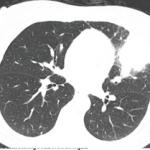The findings also raise some intriguing issues about the ability of some tumors with high mutation rates (e.g., lung, melanoma) or microsatellite DNA instability (e.g., colorectal) to cause autoimmunity.8 After all, aside from lymphoma, these are among the most common cancers that afflict our patients. Causal or coincidental?
A Balancing Act
Chronic inflammation, cancer and autoimmunity are inextricably linked, although their relationships remain poorly understood. A major hurdle is the fact that mechanisms of self-tolerance that prevent autoimmunity also impair T-cell responses against tumors, which do not differ substantially from self. However, upsetting the fine balance between cancer and autoimmunity can be hazardous. One need look no further than the warning labels of most of our biologic drugs. Thus, it’s encouraging to note the recent success of immunotherapy in treating some malignant disorders via blockade of the major checkpoint inhibitors, cytotoxic T-lymphocyte antigen 4 (CTLA-4) and programmed cell death 1 (PD-1).9 In some conditions, one may even track patient outcomes by observing whether the cancer therapy induced an aberrant autoimmune response. Example: Patients with advanced forms of melanoma who developed a vitiligo-like skin depigmentation following immunotherapy were two to four times less likely to suffer disease progression or death, compared with treated patients without this development—paraneoplasia in reverse. I wish Maria were still around to hear this news. No doubt, she would have broken out another box of cannoli.

Simon M. Helfgott, MD, is associate professor of medicine in the Division of Rheumatology, Immunology and Allergy at Harvard Medical School in Boston.
References
- Lyons AS, Petrucelli RJ. Medicine: An Illustrated History. New York, Abrams Inc. Publishers, 1978;216.
- Craig JW. Hypertrophic pulmonary osteoarthropathy as the first symptom of pulmonary neoplasm. Brit Med J. 1937 Apr 10;1(3979):750–752.
- Dickinson CJ, Martin JF. Megakaryocytes and platelet clumps as the cause of finger clubbing. Lancet. 1987 Dec 19;2(8573):1434–1435.
- Manger B, Schett G. Paraneoplastic syndromes in rheumatology. Nat Rev Rheumatol. 2014 Nov;10(11):662–670.
- Auche M. Des nevrites peripheriques chez les cancereux. Rev Med. 1890;10:785–807.
- Manger B, Schett G.s.Palmar fasciitis and polyarthritis syndrome—Systematic literature review of 100 case Semin Arthritis Rheum. 2014 Aug;44(1):105–111.
- Joseph CG, Darrah E, Shah AA, et al. Association of the autoimmune disease scleroderma with an immunologic response to cancer. Science. 2014 Jan 10;343(6167):152–157.
- Teng MWL, Smyth MJ. Can cancer trigger autoimmunity? Science. 2014 Jan 10;343(6167):147–148.
- Boussiotis VA. Soamtic mutations and immunotherapy outcome with CTLA-4 blockade in melanoma. N Engl J Med. 2014 Dec 4;371(23):2230–2232.
- Teulings HE, Limpens J, Jansen SN, et al. Vitiligo-like depigmentation in patients with stage III-IV melanoma receiving immunotherapy and its association with survival: A systematic review and meta-analysis. J Clin Oncol. 2015 Jan 20;10.1200/JCO.2014.57.4756.
Correction
An astute reader, Martina Lilleston, brought an error to our attention. In Coding Corner, December 2014 TR, the final sentence stated: “The patient was injected with 20 mg of hyaluronate without ultrasound guidance.” It should have read, “The patient was injected with 20 mg of hyaluronate with ultrasound guidance.” The answer remains: 20611.


